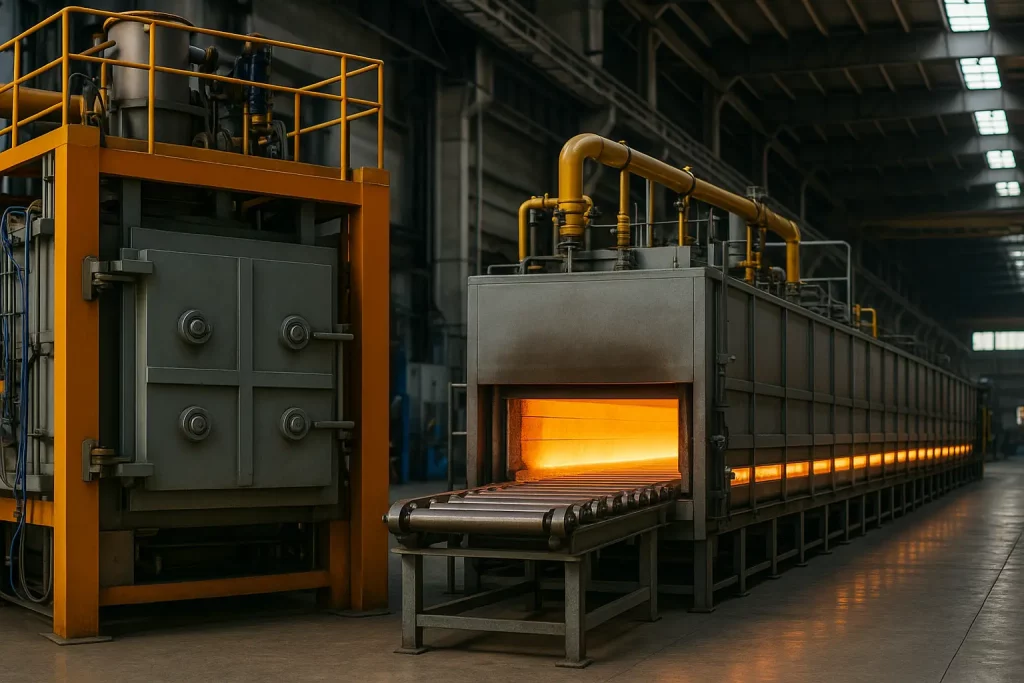
When it comes to industrial heat treatment, selecting the right furnace type is critical to both product quality and operational efficiency. Two of the most widely used furnace types are batch furnaces and continuous furnaces, each suited for different production needs. But how do you know which one is right for your industry?
Choosing between batch and continuous furnaces is not just a matter of preference—it depends on your production volume, material type, heat treatment goals, and overall process flow. Companies like Precons Furnaces, with decades of experience in thermal processing, guide industries in making informed selections by offering tailored solutions.
What Is a Batch Furnace?
A batch furnace is a heat treatment system that processes materials in discrete loads. Once one batch completes its thermal cycle, a new batch is loaded into the same chamber.
Ideal For:
- Low to medium production volumes
- Precision control over heat cycles
- Industries that require flexibility (tool manufacturing, aerospace, R&D)
Advantages:
- Greater temperature and atmosphere control per batch
- Easier changeover between materials or product types
- Better suited for high-value or specialty components
- Lower upfront costs for small-scale applications
Limitations:
- Downtime between batches reduces throughput
- Labor-intensive loading and unloading
- Less efficient for continuous or high-speed operations
What Is a Continuous Line Furnace?
A continuous line furnace moves materials steadily through a heating chamber via conveyors, rollers, or belts. The process is designed for consistent, high-volume operations.
Ideal For:
- Mass production environments
- Automotive, electronics, and metallurgy sectors
- Uniform processing of similar components
Advantages:
- Higher productivity due to nonstop operation
- Uniform temperature and cycle times for each part
- Integration with automation and robotics
- Lower cost per unit in large-scale manufacturing
Limitations:
- Higher initial investment
- Less flexible for varied product sizes or cycles
- It is challenging to clean or modify once commissioned
Which One Should You Choose?
| Criteria | Batch Furnace | Continuous Furnace |
|---|---|---|
| Production Volume | Low to Medium | Medium to High |
| Product Variability | High (different shapes, alloys) | Low (standardized parts) |
| Investment Cost | Lower Initial | Higher Initial |
| Energy Efficiency | Moderate | High |
| Flexibility | Excellent | Limited |
Precons Furnaces: Expertise in Both Solutions
Whether you’re scaling up your production or handling high-precision components, Precons Furnaces offers world-class batch and continuous furnace solutions customized to your requirements. Their in-house engineering capabilities include:
- Thermal simulation and FEA design validation
- Controlled atmosphere and vacuum furnace systems
- PLC/SCADA-based automation with data logging
- Energy optimization and modular design scalability
Precons doesn’t just deliver furnaces—they deliver performance, reliability, and ROI that lasts across industries.
Precons Furnaces Success with Furnace Precision
Global players, such as Precons Furnaces, known for their high-precision rotary dies and tooling components, rely on consistency in metallurgical properties. Precons’ batch furnace designs help maintain the required microstructure and hardness profiles batch after batch. Their collaboration demonstrates how the right furnace type plays a critical role in product excellence.
Need help deciding between batch and continuous furnaces? Connect with Precons Furnaces for a customized consultation and expert solution tailored to your workflow.